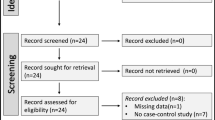Abstract
Interstitial lung disease (ILD) is the leading cause of systemic sclerosis (SSc) related morbidity and mortality. LL-37 peptide is the only cathelicidin of the human antimicrobial peptide family with antimicrobial effects and immunomodulatory activity. LL-37 has anti-fibrotic effects and anti-apoptotic effects on SSc dermal fibroblasts. The aim of the study was to investigate the circulating levels of LL-37 in SSc patients and its association with clinical, laboratory, and instrumental parameters. Fifty-eight SSc patients (30 with and 28 without pulmonary involvement) and 28 healthy controls were enrolled in the study. Pulmonary involvement was defined when ILD was found at HRCT (ground glass, reticular, and honeycombing pattern). Circulating LL-37 levels were measured with ELISA test. In SSc patients with ILD serum, LL-37 concentrations were remarkably lower (1.36 mg/ml) than those in SSc patients without ILD (4.62 ng/ml, p = 0.035) and controls (5.53 ng/ml, p = 0.009). In SSc patients without ILD, serum LL-37 levels were not different from controls (p = 0.812). No significant association or correlation was found between LL-37 levels and any other clinical, serological, or instrumental features. Serum LL-37 levels are significantly lower in patients with SSc ILD. Our results may suggest that lower LL-37 levels may be associated with the development of ILD. Whether circulating levels of LL-37 might be used as an indirect marker of ILD remains to be determined in larger SSc cohorts.
Similar content being viewed by others
References
LeRoy EC, Black C, Fleischmajer R et al (1988) Scleroderma (systemic sclerosis): classification, subsets and pathogenesis. J Rheumatol 15:202
Varga J, Abraham D (2007) Systemic sclerosis: a prototypic multisystem fibrotic disorder. J Clin Invest 117(3):557–567
Cappelli S, Guiducci S, BellandoRandone S, Matucci Cerinic M (2013) Immunosuppression for interstitial lung disease in systemic sclerosis. Eur Respir Rev 22(129):236–243
Burton MF, Steel PG (2009) The chemistry and biology of LL-37. Nat Prod Rep 26(12):1572–1584
Bucki R, Leszczynska K, Namiot A, Sokolowski W (2010) Cathelicidin LL-37: a multitask antimicrobial peptide. Archivumimmunologiaeettherapiaeexperimentalis 58(1):15–25
Tecle T, Tripathi S, Hartshorn KL (2010) Review: defensins and cathelicidins in lung immunity. Innate Immun 16(3):151–159
Shaykhiev R, Beisswenger C, Kandler K, Senske J, Puchner A, Damm T et al (2005) Human endogenous antibiotic LL-37 stimulates airway epithelial cell proliferation and wound closure. Am J Physiol Lung Cell Mol Physiol 289(5):L842–L848
Vandamme D, Landuyt B, Luyten W, Schoofs L (2012) A comprehensive summary of LL-37, the factotum human cathelicidin peptide. Cell Immunol 280(1):22–35
Park HJ, Cho DH, Kim HJ, Lee JY, Cho BK, Bang SI et al (2009) Collagen synthesis is suppressed in dermal fibroblasts by the human antimicrobial peptide LL-37. J Invest Dermatol 129(4):843–850
Kim HJ, Cho DH, Lee KJ, Cho CS, Bang SI, Cho BK et al (2011) LL-37 suppresses sodium nitroprusside-induced apoptosis of systemic sclerosis dermal fibroblasts. Exp Dermatol 20(10):843–845
Furst DE, Clements PJ, Steen VD, Medsger TA Jr, Masi AT, D'Angelo WA et al (1998) The modified Rodnan skin score is an accurate reflection of skin biopsy thickness in systemic sclerosis. J Rheumatol 25(1):84–88
Cutolo M, Matucci Cerinic M (2007) Nailfold capillaroscopy and classification criteria for systemic sclerosis. Clin Exp Rheumatol 25(5):663–665
Brown KL, Poon GF, Birkenhead D, Pena OM, Falsafi R, Dahlgren C et al (2011) Host defense peptide LL-37 selectively reduces proinflammatory macrophage responses. J Immunol 186(9):5497–5505
Into T, Inomata M, Shibata K, Murakami Y (2010) Effect of the antimicrobial peptide LL-37 on Toll-like receptors 2-, 3- and 4-triggered expression of IL-6, IL-8 and CXCL10 in human gingival fibroblasts. Cell Immunol 264(1):104–109
Behr J, Furst DE (2008) Pulmonary function tests. Rheumatology 47(Suppl 5):v65–v67
Agerberth B, Charo J, Werr J, Olsson B, Idali F, Lindbom L et al (2000) The human antimicrobial and chemotactic peptides LL-37 and alpha-defensins are expressed by specific lymphocyte and monocyte populations. Blood 96(9):3086–3093
Muangchant C, Pope JE (2013) The significance of interleukin-6 and C-reactive protein in systemic sclerosis: a systematic literature review. Clin Exp Rheumatol 31(2 Suppl 76):122–134
Aberg KM, Radek KA, Choi EH, Kim DK, Demerjian M, Hupe M et al (2007) Psychological stress downregulates epidermal antimicrobial peptide expression and increases severity of cutaneous infections in mice. J Clin Invest 117(11):3339–3349
Conflict of interest
The authors declare that they have no conflict of interest.
Author information
Authors and Affiliations
Corresponding authors
Additional information
Mutlu Hizal and Cosimo Bruni are co-first author of this paper.
Rights and permissions
About this article
Cite this article
Hizal, M., Bruni, C., Romano, E. et al. Decrease of LL-37 in systemic sclerosis: a new marker for interstitial lung disease?. Clin Rheumatol 34, 795–798 (2015). https://doi.org/10.1007/s10067-014-2854-1
Received:
Accepted:
Published:
Issue Date:
DOI: https://doi.org/10.1007/s10067-014-2854-1




